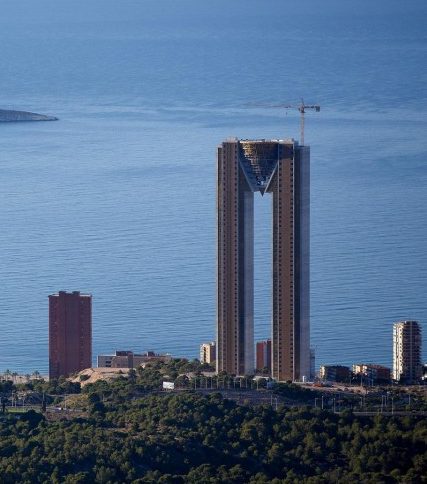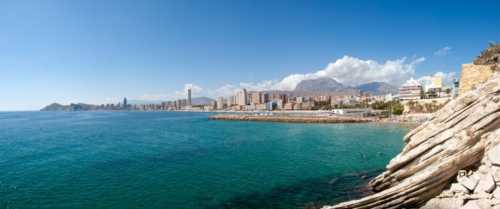Benidorm
Summer is here and people from all over Europe and the rest of Spain flock to the Valencia coast. Towns like Cullera, Gandia, Calpe and Dénia increase their populations tenfold in the summer months. Valencia prides itself on its wealth of history, architecture and art but it is sun, sea and sand, a formula that has worked magic for nearly a century, which really brings punters in. Nowhere is this truer than in the jewel in the Valencia coastal crown, Benidorm.
Benidorm is a tourist industry phenomenon on a world scale. It accounts, on its own, for more than 50% of all annual tourism to the Valencia region. It receives five million visitors every year and fills more hotel rooms than any other town or city in the whole of Europe with the exception of London and Paris. Formerly a tiny Moorish settlement, it was colonised after the re-conquest by Christians led by Admiral Bernat de Sarrià in 1325. He built a castle on the peninsula and a small community developed around the castle.
It survived centuries of occupations and attacks by pirates but the population never rose above 3,000 until the beginning of the twentieth century, when the moustachioed and stripy swim-suited Alicante and Madrid upper classes started to arrive on the recently completed Madrid to Alicante and Alicante to Altea railway links.
In 1925 the first seaside chalets were built along its beautiful beaches. The population had increased to nearly 7,000 by 1950, with most of the new arrivals working in newly built hotels and guest houses. Had it not been for the vision of one remarkable man, Benidorm may well have stopped there, happily living out its days as a kind of sunnier version of Skegness or Bognor Regis with a relatively small but regular stream of mostly local visitors.
Pedro Zaragoza was appointed (not elected, Spain didn’t go in for elections much in those days) mayor of Benidorm in 1950. Now considered by many economists and town planners as a true visionary, Pedro came to power at a time when foreign visitors were starting to arrive to the Valencia coast. More than anyone at the time, he saw the potential in this. He realised that a town could be built and economically developed purely based on the popularity of its beaches.
In 1956 he drew up Spain’s first General Urban Organisation Plan in which he envisioned a town constructed entirely and solely with the aim of promoting tourism with wide avenues and tall buildings so ‘‘everyone will have a view of the sea’’. Many have copied the idea but Pedro got in there first. He set around Spain and Europe in any way he could (most famously the wonderfully awful Benidorm international song festival) and creating an affordable place where, in his words, ‘‘people who never saw the sea in their everyday lives could spend a week or two next to the Mediterranean’’. At the same time he would also, of course, create a huge money making machine.
One illustration of the lengths Pedro would go to in order to defend his dream (and his own and his business friends’ bank accounts) is what has become known as ‘the Bikini Wars’. Back in the ‘50s (mostly foreign) women started to wear bikinis on Valencia’s beaches. This was extremely frowned upon in Catholic Spain and the garment was reluctantly tolerated for swimming in the sea but banned everywhere else. Pedro Zaragoza was highly critical of the ban and, after threats of excommunication by the Bishop of Valencia and an incident where a British woman was fined 40,000 pesetas (a huge sum back then) for wearing a bikini in a bar, he set off on his Vespa on a six-hour journey to Madrid to take the issue to a higher power. In Madrid he somehow managed to get an audience with Franco. I don’t know if either Pedro or the General tried on a bikini during the meeting but Franco ended the ban and they became lifelong associates.
Throughout the ‘60s, ‘70s, ‘80s and on to the present day, tourists came by the bucket load and the population increased to 50,000 permanent residents and 400,000 visitors at any given time during the summer months. When asked about Spain, a whole generation of northern Europeans would identify Benidorm before Valencia, Madrid or Barcelona. When explaining where Valencia is, it’s often easier to say, ‘‘It’s just up the coast from Benidorm’’. Guadalest, a pleasant but uninteresting little medieval town, has become the second most visited historical site in Spain (after the Alhambra) solely by virtue of being an easy day trip away from Benidorm.
Part of Pedro’s legacy is the ‘‘little Manhattan’’ of skyscrapers that crowd the bay in the shade of the Puig Campana mountain. The mountain’s strange shape is explained by one local legend claiming that a large piece was cut out by a giant called Roldán and thrown into the sea to form the island which decorates the bay.
There are easily more 100-metre-plus buildings (including the 186-metre-high Gran Hotel Bali, which was the tallest building in Spain until 2008) concentrated here than anywhere else in the country, all surrounding what Ian Gibson described as Spain’s best beaches, Levante and Poniete.
It is this huge development, however, which has been the sour aftertaste of Pedro Zaragoza’s dream. Only a few places along the Valencia coast have been left untouched with apartments on every hillside and tower blocks rising above every beach and ‘cala’. The coast is littered with red-faced, tattooed, short-haired men drinking bitter outside bars with photograph menus advertising beans on toast with ‘normal’ bread. Now with the crunch many developers have scarpered, leaving unfinished constructions and leaving people’s dreams shattered. The cost to the countryside and the environment is obvious but without it Valencia would be bereft of the true driving force of its economy. And millions of working people all over Europe would not have been able to live Pedro’s dream of a few weeks of fun and sun by the sea.
David Rhead and José Marín
Related Post
This site uses Akismet to reduce spam. Learn how your comment data is processed.


























Leave a comment